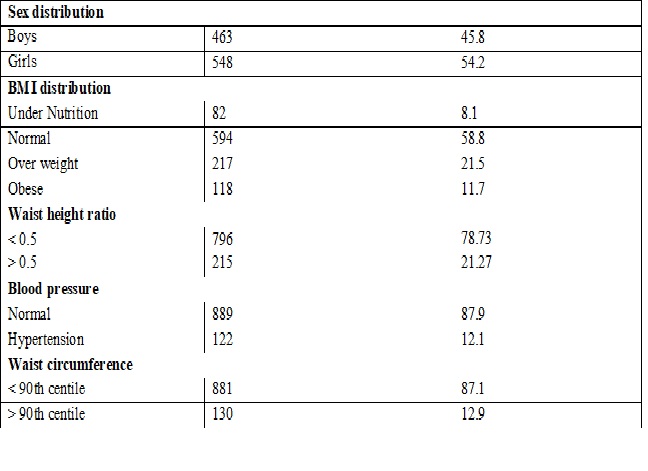A study on evaluation of waist height ratio as a screening tool for obesity
Abstract
Introduction:Childhood obesity has become a single marker for children at risk for development of various non-communicable diseases later in life. This study is conducted to estimate the prevalence of obesity and the risk factors associated with it and to evaluate Waist Height Ratio(WHtR)as a screening tool to identify obesity in children.
Materials and Methods:Across sectional study of children between 10 and 15 years of age from upper socioeconomic class from 2 urban schools.
Results: The prevalence of obesity is 11.7% and prevalence of asymptomatic hypertension is 12%. The Waist height ratio is more than 0.5 in 21.2%. About 50.5% of obese and 40.5% of overweight children had a WtHR of >0.5. Waist Height Ratio correlated significantly with all 5 risk factors taken for the study.
Conclusion: The prevalence of obesity in children between 10 to 15 years of age in this study is 11.7%. The Waist Height Ratio correlated significantly with the risk factors. Larger studies specific to Indian children are needed to make a clear cutoff value for WHtR to improve the sensitivity of screening.
Downloads
References
2. Warden NAS, Warden CH, Biological influences on obesity. Pediatr Clin N Am 200 1; 48 (4): 879 - 891.[pubmed]
3. Styne DM. Childhood and adolescent obesity. Pediatr Clin N Am 2001; 48(4); 823 - 847.[pubmed]
4. Obesity: Preventing and managing the global epidemic. Report of a WHOconsultation. Geneva: World Health Organization 2000 (WHO technical Report series No.894).
5. Alemzadeh R, Rising R, Cedillo M, Lifeshitz F. Obesity in children. Peditric Endocrinology, Fourth edition, Marcel Dekker, Inc. 2003; 823 - 858.
6. Update on the 1987 Task Force on High Blood Pressure in children and Adolescents: A Working Group Report the National High Blood Pressure Education Program. Pediatr 1996: 98 (4) 649-698.
7. Birch LL. Davison KK. Family environmental factors influencing the developing behavioral controls of food. intake and childhood over-weight. Pediatr Clin N Am 2001; 48: 983-997
8. Bhave S, Bavdekar A, Otiv M. IAP National Task Force for childhood Prevention of Adult Diseases: Childhood obesity. 2004; 41: 559 - 575.[pubmed]
9.Kapil U, Singh P, Pathak P. Dwivedi SN, BhasinS.Prevalence of obesity amongst affluent adolescent school children in Delhi, Indian Pediatr 2002; 39: 449 - 452.[pubmed]
10. M HosseinThe Relation of Body Mass Index and Blood Pressure in Iranian Children and Adolescents Aged 7–18 Years Old. 2010 v 39(4);[pubmed]
11.Yaling Zhao Fast food consumption and its associations with obesity and hypertension among children: NCBI BMC; dec 2017 v.17 page no 933.[pubmed]
12. Hazzaa Al-Hazzaa Physical activity, sedentary behaviors and dietary habits among Saudi adolescents relative to age, gender and region. International Journal of Behavioral Nutrition and Physical Activity 2011, 8:140.[pubmed]
13. Gregor Hasler The Association Between Short Sleep Duration and Obesity in Young Adults a 13-Year Prospective Study. 1 June 2004 Volume 27, Issue 4, , Pages 661–666
14. Irene Braithwaite The Worldwide Association between Television Viewing and Obesity in Children and Adolescents: NCBI 2013 Sep vol 8
15. Robinson TN. Television viewing and childhood obesity. Pediatr Clin N Am 200 1; 1017 – 1023.[pubmed]
16. Hancox RJ, Poulton R (2006) Watching television is associated with childhood obesity: but is it clinically important? Int J Obes (Lond) 30: 171–175.[pubmed]
17. MaCarthy el al. A study of central fatness using waist-to-height ratios in UK children and adolescents.PubMed 2006 Jun;30(6):988-92.[pubmed]
18. Michael Khoury Role of the Waist/Height Ratio in the Cardiometabolic Risk Assessment of Children Classified by Body Mass Index Journal of the American College of Cardiology Volume 62, Issue 8, 20 August 2013, Pages 742-751
19. PE Mishra Waist-to-Height Ratio as an Indicator of High Blood Pressure inUrban Indian School Children Indian Pediatrics journal July 15, 2015. Vol 52.
20. SeejaThomachanPanjikkaranWaist to Height Ratio for Recording the Risks of Overweight in South Indian School-childrenjune 2014.

Copyright (c) 2018 Author (s). Published by Siddharth Health Research and Social Welfare Society

This work is licensed under a Creative Commons Attribution 4.0 International License.


 OAI - Open Archives Initiative
OAI - Open Archives Initiative


